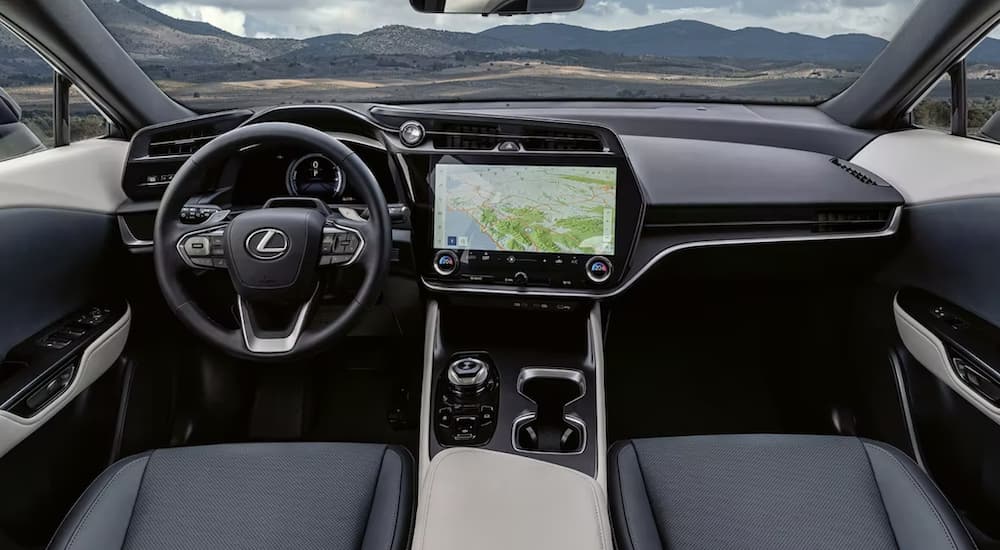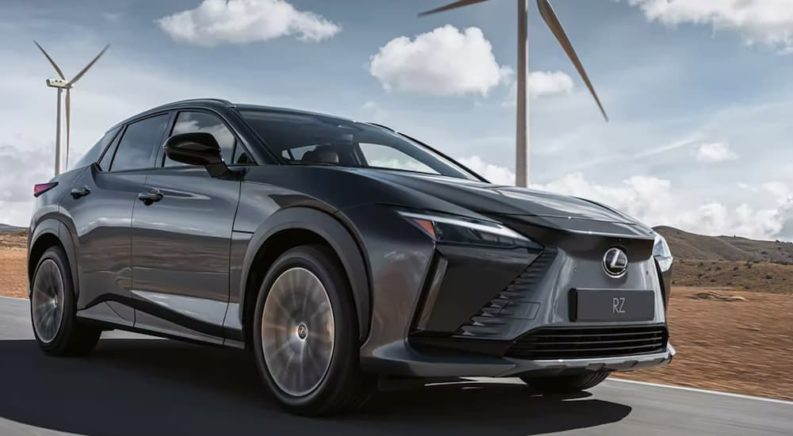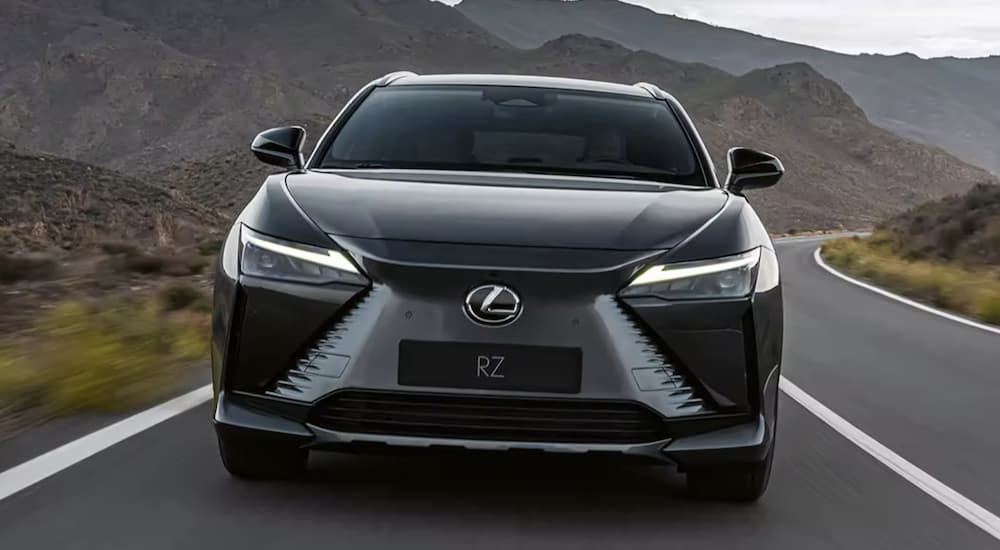This spring, Lexus announced an electric alternative to the next-generation RX called RZ. Built on the same platform as the co-developed Subaru Solterra and Toyota bZ4X, there is much about the RZ to generate interest. However, perhaps nothing is drawing more attention than the optional One Grip Steering control system. The pictures show, and the press release announcing the vehicle confirmed, that the RZ will have an optional yoke-style steering control system. The system involves more than just a stylistic change: the entire steering mechanism is replaced with “steer-by-wire!” Neither of these is a totally novel concept in its own right, but their marriage may be what it takes for both to work.
Steer-by-Wire
The Infiniti Q50 was the first to introduce steer-by-wire technology to the public back in 2014. The concept does away with a steering column and instead uses computers to translate steering input into rotational output (although the Q50 retains a steering column to this day as a backup in the event that steer-by-wire fails). The technology has long been viewed as an essential stepping stone towards autonomous driving, allowing for reduced weight and improved lane keep assist functions, with the secondary benefits of reduced NVH and more responsive handling.
Of course, an enthusiast might read that as “soulless and lifeless,” but such is our curse, especially when it’s installed on the 370Z-based luxury sedan. Updated in 2018, Infiniti’s system was then reviewed as improved––still less engaging than mechanical steering under spirited driving conditions, but otherwise, the difference was imperceptible, which is sometimes the highest praise one can give to new technology.
Steer-by-wire has been the norm in aviation for decades, where the weight-saving and reliability benefits of eliminating mechanical linkages from the cockpit to distant wing flaps are perhaps more obvious. Maybe those of us who lament the sacrifice of the automotive soul at the altar of “Big Brother, the Student Driver” can find solace in the knowledge that when we use steer-by-wire, we’re using the same technology that’s in the F-16 fighter jet––maybe.

Yoke Control
The other key aspect of Lexus’ new steering control is the yoke. The 2021 Tesla Model S was the first mass-market vehicle to offer a yoke, along with the polarizing decision to not offer any alternatives. It’s not uncommon for concept cars to feature yoke controllers, and the most famous yoke-controlled car has got to be KITT from Knight Rider, but nobody had brought this piece of aviation technology to the public until this decade.
To call the Plaid’s yoke a controversial design piece is a severe understatement. T Sportline, the self-proclaimed original Tesla tuner shop, went so far as to develop a modification for the yoke that made it a complete rectangular-ish wheel. It wasn’t entirely settled whether the yoke was even legal until early 2021, and many of its detractors have called it downright unsafe with a “potentially dangerous learning curve.”
On the surface, this is a strange finding. Yoke technology has long been a staple in aviation, where the design’s adaptability to control roll, pitch, and yaw simultaneously is a boon. Formula One and several other top-tier racing classes have used yoke controls for years as well. So, why is it that early adopters find it a threat to their safety in a road car?
Formula 1 – Driven by Necessity
While much of the technology developed in racing eventually trickles down into sports cars and then mass-market economy cars, the yoke never has because its purpose is extremely specific to its application. Nigel Mansell and Ayrton Senna used round steering wheels as recently as the early 1990s, but by the turn of the millennium, the era of shoving buttons, dials, and screens into the steering device had begun, and Mika Hakkinen and David Coulthard had distinctly un-wheellike steering controls on the McLaren team.
Cramped cockpits made large wheels less tenable, and it appears that in an effort to reduce mass as much as anything, the upper and lower parts of the round wheel were chopped off by more and more drivers. As the lock-to-lock steering range of an F1 race car is barely 1.5 turns (if that), there’s no need for an F1 driver to practice hand-over-hand steering. By keeping their hands in the same part of the control at all times, they can use muscle memory to manage the myriad control functions that have become standard in modern racing. Ergo: who needs a wheel?
Why It Doesn’t Work
The answer, of course, is “normal people.” A normal lock-to-lock range for a road car is a full 2.5 turns, so unless your name is Dr. Reed Richards, some degree of hand-over-hand, throw-and-catch, or palm steering is absolutely necessary for low-speed turning maneuvers. What early adopters of Tesla’s system found was that when their muscle memory reached for the wheel to execute a sharp turn, they grabbed empty space where the wheel ought to have been, leading to a temporary but dangerous loss of control of the vehicle.
That wasn’t the only problem with the Tesla yoke. With the horn relegated to a button off to the side of center somewhere, drivers found it difficult to use in the kinds of hazardous situations that demanded it. Reviewers even found that the ease of ingress and egress was compromised, not having realized how much they depended on the top portion of a steering wheel for leverage and stability as they climbed into or out of their normal cars. However, in my opinion, these are mere nuisances, while the need to completely retrain decades of muscle memory to avoid a hand-over-hand slip-up is terminal.
Why It’s Going to Work
By combining steer-by-wire with a yoke, however, Lexus is going to succeed where Tesla has arguably failed. Because the technology is completely computer-controlled, there’s no need for a variable ratio gearbox in the steering linkages to adjust steering sensitivity on the fly. Lexus’ system takes the driver input, combined with road speed and other sensor-collected data, to identify the appropriate level of responsiveness every time a steering action begins (the system will essentially only change sensitivity when the car is moving straight, for predictability).
Sensitivity is lowered at high speeds and heightened at low speeds––it’ll change lanes gently on the highway but readily curl into a parking spot with the same amount of input. This means that the roughly 150-degree lock-to-lock turn (about one-third of a full turn to the left and right), easily managed without ever taking one’s hands off the wheel, provides an appropriate response under all conditions. Lexus appropriately calls this extreme sensitivity adjustment system “One Grip Steering.”
Why Yoke at All?
The big question is really, “why?”. Infiniti didn’t use a yoke and still offers steer-by-wire on the Q50 today. Lexus could have implemented the One Grip Steering functionality on a steering wheel (although that again would beg the question, “why?”)––so why take on this controversial and alien design?
The answer lies in the motivation for using steer-by-wire in the first place. Yes, short-term, it enables more effective advanced driver assists, better fuel efficiency, and a smoother ride, all huge benefits to normal drivers. But the long-term benefit is its applicability to autonomous vehicles, and that is the motive behind using a yoke as well.
First of all, the upper part of a steering wheel is visually obstructive. It limits a driver’s view of the road and instrument panel while also limiting an onboard camera’s view of the driver. In the nearer future, as semi-autonomous (i.e., self-driving with supervision) technology becomes more prevalent, it’s important for the onboard systems to know that the driver has their back, so to speak, by monitoring the driver’s eyes. A yoke accommodates this more readily than a wheel while also enabling a lower dashboard to improve outward visibility for the driver. The e-TNGA platform that the RZ is based on includes this exact design element.
In the more distant future, when truly autonomous driving is the norm, it’s likely that some form of manual steering control will still be required on most (if not all) vehicles. This runs somewhat contrary to the concepts that companies like Nissan have been putting forth, which envision the car of the future as a mobile office or living room––a comfortable, aesthetically pleasing place no different than any (small) room in your home, except that it’s moving.
A large steering control device projecting into this environment somewhat cramps the style, so conceptual plans involve retracting the controller entirely during autonomous driving. Why a yoke? Because it’s much smaller, it’s that much easier to hide!
Steering the Design of the Future
In summary, Lexus and Toyota have surprised the industry with a yoke-controlled steer-by-wire system, the first of its kind, included as an option in the new RZ and bZ4X electric crossover models (the Subaru Solterra does not offer this system). It’s a surprise because only Infiniti has used steer-by-wire in the market so far, and it remains limited to the Q50 and Q60––which retain the steering column as a backup. Nobody has offered a fully-committed steer-by-wire option to date.
It’s controversial because Tesla’s yoke-only Model S Plaid has proven hazardously difficult to adjust to, despite the cool aesthetic it provides. Despite this legacy, Lexus’ system is going to work because it takes advantage of steer-by-wire to adjust steering sensitivity according to speed, which is going to make 95% of the experience for 95% of drivers smoother, easier, and more relaxed overall.
Lexus is playing the role of early adopter for a technology that may be the way of the future. Tesla failed to take its design seriously, but it appears that Lexus saw the gap between Formula 1 and Tesla yoke designs and made the necessary adjustment. Time will tell if this is indeed forging the path forward or just a mess of scrambled eggs.





